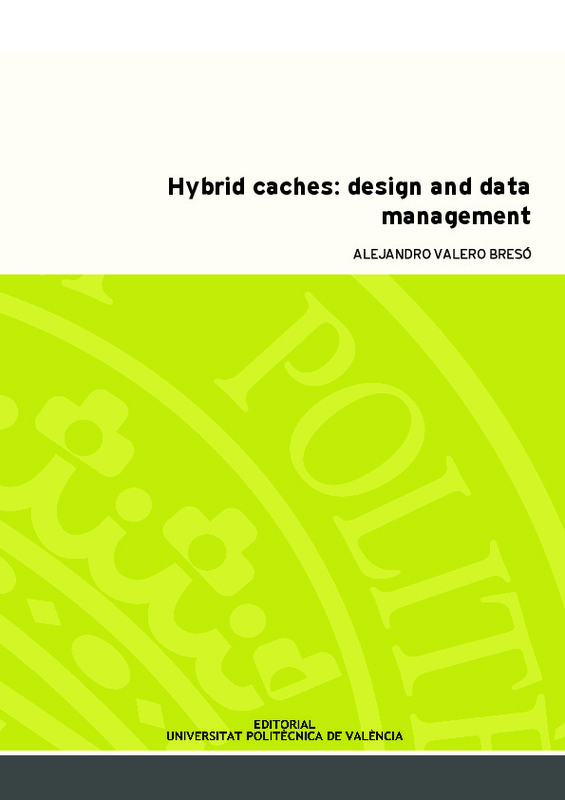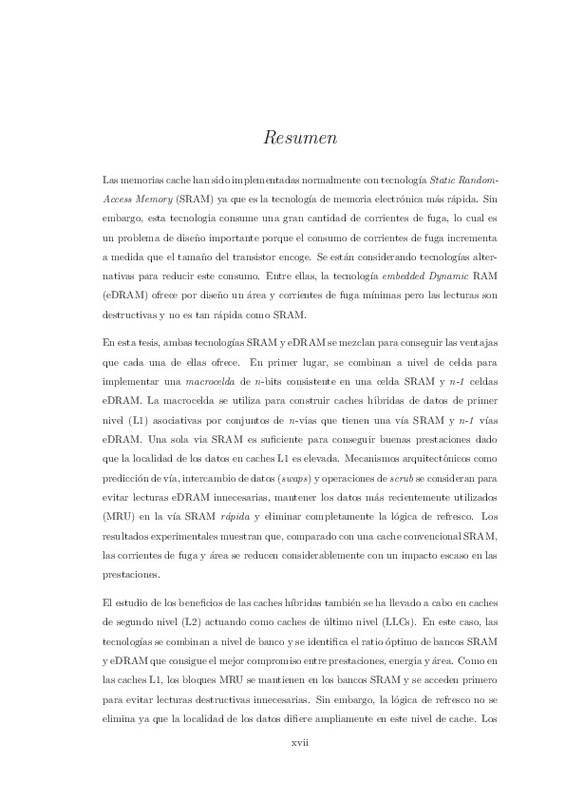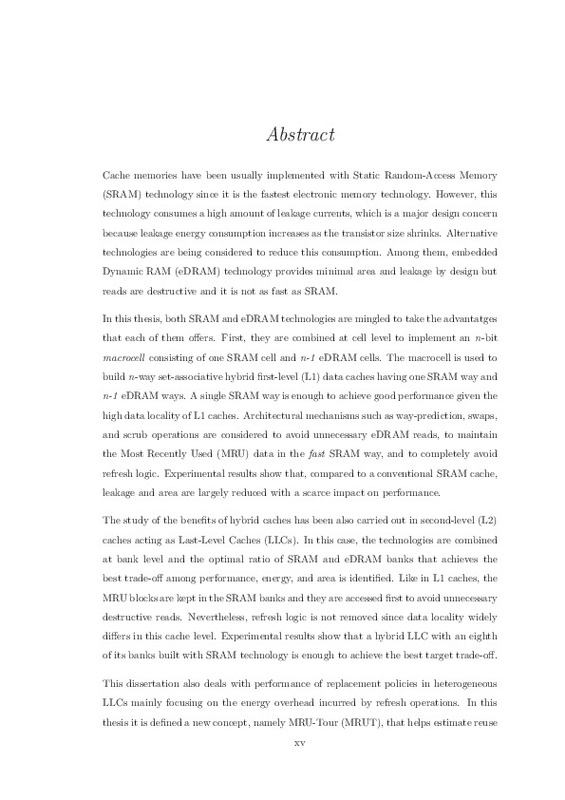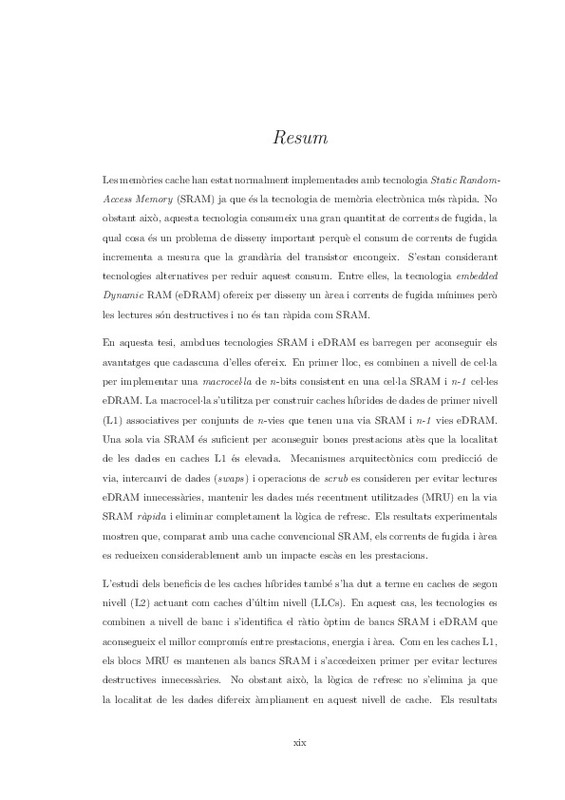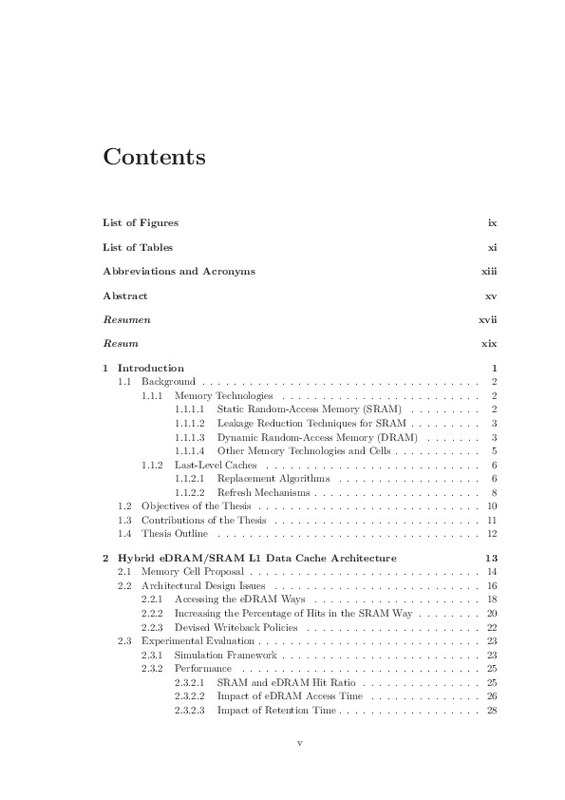- RiuNet repositorio UPV
- :
- Investigación
- :
- Tesis doctorales
- :
- Ver ítem
JavaScript is disabled for your browser. Some features of this site may not work without it.
Buscar en RiuNet
Listar
Mi cuenta
Estadísticas
Ayuda RiuNet
Admin. UPV
Hybrid caches: design and data management
Mostrar el registro sencillo del ítem
Ficheros en el ítem
| dc.contributor.advisor | Petit Martí, Salvador Vicente
|
es_ES |
| dc.contributor.advisor | Sahuquillo Borrás, Julio
|
es_ES |
| dc.contributor.author | Valero Bresó, Alejandro
|
es_ES |
| dc.date.accessioned | 2013-10-07T08:38:50Z | |
| dc.date.available | 2013-10-07T08:38:50Z | |
| dc.date.created | 2013-09-16T09:00:07Z | es_ES |
| dc.date.issued | 2013-10-07T08:38:47Z | es_ES |
| dc.identifier.isbn | 978-84-9048-137-0 | |
| dc.identifier.uri | http://hdl.handle.net/10251/32663 | |
| dc.description.abstract | Cache memories have been usually implemented with Static Random-Access Memory (SRAM) technology since it is the fastest electronic memory technology. However, this technology consumes a high amount of leakage currents, which is a major design concern because leakage energy consumption increases as the transistor size shrinks. Alternative technologies are being considered to reduce this consumption. Among them, embedded Dynamic RAM (eDRAM) technology provides minimal area and leakage by design but reads are destructive and it is not as fast as SRAM. In this thesis, both SRAM and eDRAM technologies are mingled to take the advantatges that each of them o¿ers. First, they are combined at cell level to implement an n-bit macrocell consisting of one SRAM cell and n-1 eDRAM cells. The macrocell is used to build n-way set-associative hybrid ¿rst-level (L1) data caches having one SRAM way and n-1 eDRAM ways. A single SRAM way is enough to achieve good performance given the high data locality of L1 caches. Architectural mechanisms such as way-prediction, swaps, and scrub operations are considered to avoid unnecessary eDRAM reads, to maintain the Most Recently Used (MRU) data in the fast SRAM way, and to completely avoid refresh logic. Experimental results show that, compared to a conventional SRAM cache, leakage and area are largely reduced with a scarce impact on performance. The study of the bene¿ts of hybrid caches has been also carried out in second-level (L2) caches acting as Last-Level Caches (LLCs). In this case, the technologies are combined at bank level and the optimal ratio of SRAM and eDRAM banks that achieves the best trade-o¿ among performance, energy, and area is identi¿ed. Like in L1 caches, the MRU blocks are kept in the SRAM banks and they are accessed ¿rst to avoid unnecessary destructive reads. Nevertheless, refresh logic is not removed since data locality widely di¿ers in this cache level. Experimental results show that a hybrid LLC with an eighth of its banks built with SRAM technology is enough to achieve the best target trade-o¿. This dissertation also deals with performance of replacement policies in heterogeneous LLCs mainly focusing on the energy overhead incurred by refresh operations. In this thesis it is de¿ned a new concept, namely MRU-Tour (MRUT), that helps estimate reuse information of cache blocks. Based on this concept, it is proposed a family of MRUTbased replacement algorithms that randomly select the victim block among those having a single MRUT. These policies are enhanced to leverage recency of information for a few blocks and to adapt to changes in the working set of the benchmarks. Results show that the proposed MRUT policies, with simpler hardware complexity, outperform the Least Recently Used (LRU) policy and a set of the most representative state-of-the-art replacement policies for LLCs. Refresh operations represent an important fraction of the overall dynamic energy consumption of eDRAM LLCs. This fraction increases with the cache capacity, since more blocks have to be refreshed for a given period of time. Prior works have attacked the refresh energy taking into account inter-cell feature variations. Unlike these works, this thesis proposes a selective refresh policy based on the MRUT concept. The devised policy takes into account the number of MRUTs of a block to select whether the block is refreshed. In this way, many refreshes done in a typical distributed refresh policy are skipped (i.e., in those blocks having a single MRUT). This refresh mechanism is applied in the hybrid LLC memory. Results show that refresh energy consumption is largely reduced with respect to a conventional eDRAM cache, while the performance degradation is minimal with respect to a conventional SRAM cache. | en_EN |
| dc.language | Inglés | es_ES |
| dc.publisher | Editorial Universitat Politècnica de València | es_ES |
| dc.rights | Reserva de todos los derechos | es_ES |
| dc.source | Riunet | es_ES |
| dc.subject | Cache memories | es_ES |
| dc.subject | EDRAM technology | es_ES |
| dc.subject | Energy consumption | es_ES |
| dc.subject | Hybrid caches | es_ES |
| dc.subject | Last-Level Caches | es_ES |
| dc.subject | Macrocell | es_ES |
| dc.subject | MRU-Tour | es_ES |
| dc.subject | Performance | es_ES |
| dc.subject | Replacement algorithms | es_ES |
| dc.subject | Selective refresh | es_ES |
| dc.subject | SRAM technology | es_ES |
| dc.subject.classification | ARQUITECTURA Y TECNOLOGIA DE COMPUTADORES | es_ES |
| dc.title | Hybrid caches: design and data management | |
| dc.type | Tesis doctoral | es_ES |
| dc.identifier.doi | 10.4995/Thesis/10251/32663 | es_ES |
| dc.rights.accessRights | Abierto | es_ES |
| dc.contributor.affiliation | Universitat Politècnica de València. Departamento de Informática de Sistemas y Computadores - Departament d'Informàtica de Sistemes i Computadors | es_ES |
| dc.description.bibliographicCitation | Valero Bresó, A. (2013). Hybrid caches: design and data management [Tesis doctoral]. Editorial Universitat Politècnica de València. https://doi.org/10.4995/Thesis/10251/32663 | es_ES |
| dc.description.accrualMethod | TESIS | es_ES |
| dc.type.version | info:eu-repo/semantics/acceptedVersion | es_ES |
| dc.relation.tesis | 8414 | es_ES |
| dc.description.award | Premios Extraordinarios de tesis doctorales | es_ES |
Este ítem aparece en la(s) siguiente(s) colección(ones)
-
Tesis doctorales [5389]
-
Tesis. Editorial UPV [172]






